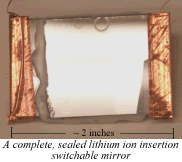APPLICATIONS OF TECHNOLOGY:
- Architectural glass
- Sunroofs and rear view mirrors
- Aerospace insolation controls
- Optical switching elements
- Thin film displays
ADVANTAGES:
- Active components are more stable than metal hydrides over time
- Low material and fabrication costs

ABSTRACT:
Switchable mirrors are a new generation of electrochromic windows that can alternate between a reflecting state and a transparent or absorbing state when a small voltage is applied. These energy saving devices have advantages over traditional absorbing electrochromics for radiant energy control because of their large dynamic range in both transmission and reflection for visible light and infrared radiation.
Applications for the new Berkeley Lab electrochromic materials described below include architectural glass, sunroofs, rear view mirrors, aerospace insolation controls, optical switching elements, and thin film displays.
Thomas Richardson of Berkeley Lab has developed a switchable mirror system based on lithium ion insertion that is inherently more stable than systems based on metal hydrides. Hydride systems suffer from poor life cycle due to the highly reactive nature of the active metal film which is easily and irreversibly oxidized by air or water. Because the Berkeley Lab device is sealed and the component electrode materials are stable with respect to the non-aqueous electrolyte, irreversible degradation of the mirror film is avoided. The devices can be made using less expensive fabrication methods and do not require the protective palladium layer needed in hydride mirrors.
A typical device consists of a thin reflective film of active material such as antimony applied to a glass substrate. The electrolyte may be a solid, liquid, or polymer. A counter electrode supplies positive lithium ions and may be transparent, opaque, reflecting, or electrochromic, depending on the application. When a potential is applied, electrons flow into the active metallic layer. At the same time, lithium ions are taken up by the metal to form a new transparent compound. The transition may be stopped or reversed at any point to achieve a desired level of transparency or reflectivity. Infrared radiation is modulated even more effectively than visible light, raising the prospect of improved energy efficiency.
A video demonstration on the technology is available here (QuickTime required).
STATUS:
- U.S. Patent #7,042,615. Available for licensing or collaborative research
PULICATIONS:
“New Electrochromic Mirror Systems,” T. J. Richardson, presentation at IME5
“New Electrochromic Mirror Systems,” T. J. Richardson, Paper at IME5
“Sb–Cu–Li electrochromic mirrors”, G. Liu, T.J. Richardson, Science Direct, 2004.
REFERENCE NUMBER: IB-1817
